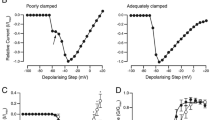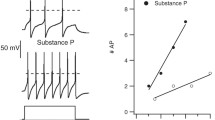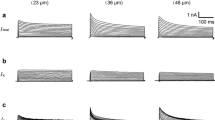Abstract
Spinal dorsal horn neurons constitute the first relay for pain processing and participate in the processing of other sensory, motor and autonomic information. At the cellular level, intrinsic excitability is a factor contributing to network function. In turn, excitability is set by the array of ionic conductance expressed by neurons. Here, we set out to characterise rebound depolarisation following hyperpolarisation, a feature frequently described in dorsal horn neurons but never addressed in depth. To this end, an in vitro preparation of the spinal cord from mice pups was used combined with whole-cell recordings in current and voltage clamp modes. Results show the expression of H- and/or T-type currents in a significant proportion of dorsal horn neurons. The expression of these currents determines the presence of rebound behaviour at the end of hyperpolarising pulses. T-type calcium currents were associated to high-amplitude rebounds usually involving high-frequency action potential firing. H-currents were associated to low-amplitude rebounds less prone to elicit firing or firing at lower frequencies. For a large proportion of neurons expressing both currents, the H-current constitutes a mechanism to ensure a faster response after hyperpolarisations, adjusting the latency of the rebound firing. We conclude that rebound depolarisation and firing are intrinsic factors to many dorsal horn neurons that may constitute a mechanism to integrate somatosensory information in the spinal cord, allowing for a rapid switch from inhibited-to-excited states.






Similar content being viewed by others
References
Aizenman CD, Linden DJ (1999) Regulation of the rebound depolarization and spontaneous firing patterns of deep nuclear neurons in slices of rat cerebellum. J Neurophysiol 82:1697–1709
Butts DA, Weng C, Jin J, Yeh CI, Lesica NA, Alonso JM, Stanley GB (2007) Temporal precision in the neural code and the timescales of natural vision. Nature 449:92–95
Cervero F, Iggo A, Molony V (1979) An electrophysiological study of neurones in the Substantia Gelatinosa Rolandi of the cat’s spinal cord. Q J Exp Physiol Cogn Med Sci 64:297–314
Chemin J, Monteil A, Perez-Reyes E, Bourinet E, Nargeot J, Lory P (2002) Specific contribution of human T-type calcium channel isotypes (alpha(1G), alpha(1H) and alpha(1I)) to neuronal excitability. J Physiol 540:3–14
Cheng JK, Lin CS, Chen CC, Yang JR, Chiou LC (2007) Effects of intrathecal injection of T-type calcium channel blockers in the rat formalin test. Behav Pharmacol 18:1–8
Choe W, Messinger RB, Leach E, Eckle VS, Obradovic A, Salajegheh R, Jevtovic-Todorovic V, Todorovic SM (2011) TTA-P2 is a potent and selective blocker of T-type calcium channels in rat sensory neurons and a novel antinociceptive agent. Mol Pharmacol 80:900–910
Engbers JD, Anderson D, Tadayonnejad R, Mehaffey WH, Molineux ML, Turner RW (2011) Distinct roles for I(T) and I(H) in controlling the frequency and timing of rebound spike responses. J Physiol 589:5391–5413
Graham BA, Brichta AM, Callister RJ (2004) In vivo responses of mouse superficial dorsal horn neurones to both current injection and peripheral cutaneous stimulation. J Physiol 561:749–763
Huang L, Keyser BM, Tagmose TM, Hansen JB, Taylor JT, Zhuang H, Zhang M, Ragsdale DS, Li M (2004) NNC 55–0396 [(1S,2S)-2-(2-(N-[(3-benzimidazol-2-yl)propyl]-N-methylamino)ethyl)-6-fluoro-1,2, 3,4-tetrahydro-1-isopropyl-2-naphtyl cyclopropanecarboxylate dihydrochloride]: a new selective inhibitor of T-type calcium channels. J Pharmacol Exp Ther 309:193–199
Huang LY (1989) Calcium channels in isolated rat dorsal horn neurones, including labelled spinothalamic and trigeminothalamic cells. J Physiol 411:161–177
Hughes DI, Sikander S, Kinnon CM, Boyle KA, Watanabe M, Callister RJ, Graham BA (2012) Morphological, neurochemical and electrophysiological features of parvalbumin-expressing cells: a likely source of axo-axonic inputs in the mouse spinal dorsal horn. J Physiol 590:3927–3951
Ikeda H, Heinke B, Ruscheweyh R, Sandkuhler J (2003) Synaptic plasticity in spinal lamina I projection neurons that mediate hyperalgesia. Science 299:1237–1240
Ikeda H, Stark J, Fischer H, Wagner M, Drdla R, Jager T, Sandkuhler J (2006) Synaptic amplifier of inflammatory pain in the spinal dorsal horn. Science 312:1659–1662
Jacus MO, Uebele VN, Renger JJ, Todorovic SM (2012) Presynaptic Cav3.2 channels regulate excitatory neurotransmission in nociceptive dorsal horn neurons. J Neurosci 32:9374–9382
Jiang YQ, Sun Q, Tu HY, Wan Y (2008) Characteristics of HCN channels and their participation in neuropathic pain. Neurochem Res 33:1979–1989
Ku WH, Schneider SP (2011) Multiple T-type Ca2+ current subtypes in electrophysiologically characterized hamster dorsal horn neurons: possible role in spinal sensory integration. J Neurophysiol 106:2486–2498
Large EW, Crawford JD (2002) Auditory temporal computation: interval selectivity based on post-inhibitory rebound. J Comput Neurosci 13:125–142
Lee JH, Gomora JC, Cribbs LL, Perez-Reyes E (1999) Nickel block of three cloned T-type calcium channels: low concentrations selectively block alpha1H. Biophys J 77:3034–3042
Lopez-Garcia JA, King AE (1994) Membrane properties of physiologically classified rat dorsal horn neurons in vitro: correlation with cutaneous sensory afferent input. Eur J Neurosci 6:998–1007
Martin RL, Lee JH, Cribbs LL, Perez-Reyes E, Hanck DA (2000) Mibefradil block of cloned T-type calcium channels. J Pharmacol Exp Ther 295:302–308
Martinez-Gomez J, Lopez-Garcia JA (2005) Electrophysiological and pharmacological characterisation of ascending anterolateral axons in the in vitro mouse spinal cord. J Neurosci Methods 146:84–90
Matthews EA, Dickenson AH (2001) Effects of ethosuximide, a T-type Ca(2+) channel blocker, on dorsal horn neuronal responses in rats. Eur J Pharmacol 415:141–149
McCormick DA, Pape HC (1990) Properties of a hyperpolarization-activated cation current and its role in rhythmic oscillation in thalamic relay neurones. J Physiol 431:291–318
McKay BE, McRory JE, Molineux ML, Hamid J, Snutch TP, Zamponi GW, Turner RW (2006) Ca(V)3 T-type calcium channel isoforms differentially distribute to somatic and dendritic compartments in rat central neurons. Eur J Neurosci 24:2581–2594
Mehrke G, Zong XG, Flockerzi V, Hofmann F (1994) The Ca(++)-channel blocker Ro 40–5967 blocks differently T-type and L-type Ca++ channels. J Pharmacol Exp Ther 271:1483–1488
Oswald AM, Chacron MJ, Doiron B, Bastian J, Maler L (2004) Parallel processing of sensory input by bursts and isolated spikes. J Neurosci 24:4351–4362
Reali C, Russo RE (2013) Neuronal intrinsic properties shape naturally evoked sensory inputs in the dorsal horn of the spinal cord. Front Cell Neurosci 7:276
Rivera-Arconada I, Lopez-Garcia JA (2010) Changes in membrane excitability and potassium currents in sensitized dorsal horn neurons of mice pups. J Neurosci 30:5376–5383
Rivera-Arconada I, Roza C, Lopez-Garcia JA (2013) Characterization of hyperpolarization-activated currents in deep dorsal horn neurons of neonate mouse spinal cord in vitro. Neuropharmacology 70:148–155
Russo RE, Hounsgaard J (1996) Burst-generating neurones in the dorsal horn in an in vitro preparation of the turtle spinal cord. J Physiol 493(Pt 1):55–66
Ryu PD, Randic M (1990) Low- and high-voltage-activated calcium currents in rat spinal dorsal horn neurons. J Neurophysiol 63:273–285
Sangrey T, Jaeger D (2010) Analysis of distinct short and prolonged components in rebound spiking of deep cerebellar nucleus neurons. Eur J Neurosci 32:1646–1657
Santoro B, Chen S, Luthi A, Pavlidis P, Shumyatsky GP, Tibbs GR, Siegelbaum SA (2000) Molecular and functional heterogeneity of hyperpolarization-activated pacemaker channels in the mouse CNS. J Neurosci 20:5264–5275
Sekiguchi F, Kawabata A (2013) T-type calcium channels: functional regulation and implication in pain signaling. J Pharmacol Sci 122:244–250
Takasu K, Ono H, Tanabe M (2010) Spinal hyperpolarization-activated cyclic nucleotide-gated cation channels at primary afferent terminals contribute to chronic pain. Pain 151:87–96
Talley EM, Cribbs LL, Lee JH, Daud A, Perez-Reyes E, Bayliss DA (1999) Differential distribution of three members of a gene family encoding low voltage-activated (T-type) calcium channels. J Neurosci 19:1895–1911
Tottene A, Volsen S, Pietrobon D (2000) alpha(1E) subunits form the pore of three cerebellar R-type calcium channels with different pharmacological and permeation properties. J Neurosci 20:171–178
Viana F, Van den Bosch L, Missiaen L, Vandenberghe W, Droogmans G, Nilius B, Robberecht W (1997) Mibefradil (Ro 40–5967) blocks multiple types of voltage-gated calcium channels in cultured rat spinal motoneurones. Cell Calcium 22:299–311
Wahl-Schott C, Biel M (2009) HCN channels: structure, cellular regulation and physiological function. Cell Mol Life Sci 66:470–494
Walsh MA, Graham BA, Brichta AM, Callister RJ (2009) Evidence for a critical period in the development of excitability and potassium currents in mouse lumbar superficial dorsal horn neurons. J Neurophysiol 101:1800–1812
Wen XJ, Xu SY, Chen ZX, Yang CX, Liang H, Li H (2010) The roles of T-type calcium channel in the development of neuropathic pain following chronic compression of rat dorsal root ganglia. Pharmacology 85:295–300
Wen XJ, Li ZJ, Chen ZX, Fang ZY, Yang CX, Li H, Zeng YM (2006) Intrathecal administration of Cav3.2 and Cav3.3 antisense oligonucleotide reverses tactile allodynia and thermal hyperalgesia in rats following chronic compression of dorsal root of ganglion. Acta Pharmacol Sin 27:1547–1552
Yoshimura M, Jessell TM (1989) Membrane properties of rat substantia gelatinosa neurons in vitro. J Neurophysiol 62:109–118
Acknowledgments
Research was supported by the Spanish Ministry of Economy and Competitiveness (Grant No. BFU 2012–37905) and the University of Alcala (Grant No. CCG2013/BIO-059). Golgi staining was performed by Sol Castillejo.
Ethical standards
Experiments were designed following the European Union and Spanish Government regulations, and the experimental protocols were approved by the University of Alcala Ethics Committee.
Conflicts of interest
The authors declare that they have no conflict of interest.
Author information
Authors and Affiliations
Corresponding author
Electronic supplementary material
Below is the link to the electronic supplementary material.
ESM 1
(PDF 106 kb)
Rights and permissions
About this article
Cite this article
Rivera-Arconada, I., Lopez-Garcia, J.A. Characterisation of rebound depolarisation in mice deep dorsal horn neurons in vitro. Pflugers Arch - Eur J Physiol 467, 1985–1996 (2015). https://doi.org/10.1007/s00424-014-1623-y
Received:
Revised:
Accepted:
Published:
Issue Date:
DOI: https://doi.org/10.1007/s00424-014-1623-y




